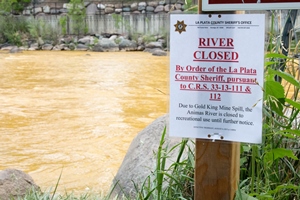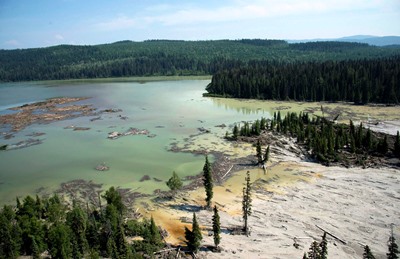The interconnected lakes and rivers of Minnesota’s canoe country are one of the largest sources of fresh water in the country. More than 250,000 people come to the Boundary Waters Canoe Area Wilderness each year to camp, canoe, fish, hunt, and unplug from their busy lives.
Some of the Izaak Walton League’s earliest fights centered on the waters along this Canadian-American border country. In 1925, Edward Backus proposed a series of dams across the big border lakes. The Izaak Walton League and the Quetico-Superior Council worked to sway the International Joint Commission (an organization created by Canada and the United States to prevent and resolve disputes in the Boundary Waters and pursue the common good) to oppose the dam proposal. After nearly a decade, the plan was finally defeated. Ikes have also prevailed in fending off roads, aircraft, use of recreational vehicles, logging, and mining that would have damaged the character of the wilderness.
In the 1960s, controversy heated up again in anticipation of The Wilderness Act of 1964. While many believed the long years of strife were over with the passing of the 1964 Wilderness Act and the 1978 Boundary Waters Act, threats along the wilderness’ mineral-rich, unprotected edges still loom today.
The Boundary Waters Canoe Area Wilderness is threatened by proposals for sulfide-ore copper mining near the town of Ely, Minnesota, virtually at the edge of the wilderness. This type of mining has never been done in Minnesota – and has yet to be done anywhere else in the world without polluting water and compromising the health of the surrounding environment and communities.
Toxic Outcomes
 Environmental Protection Agency (EPA) data show hard-rock mining to be the most toxic industry in America. Acid mine drainage, heavy metal pollution of water, and particulate air pollution are just a few side effects of copper mining. Acid mine drainage occurs when sulfide-bearing ore is exposed to air and water, creating sulfuric acid, which causes leaching of heavy metals such as lead, arsenic, copper, and mercury into the watershed. Aquatic organisms in these environments bio-accumulate heavy metals and other toxins, passing them up the food chain.
Environmental Protection Agency (EPA) data show hard-rock mining to be the most toxic industry in America. Acid mine drainage, heavy metal pollution of water, and particulate air pollution are just a few side effects of copper mining. Acid mine drainage occurs when sulfide-bearing ore is exposed to air and water, creating sulfuric acid, which causes leaching of heavy metals such as lead, arsenic, copper, and mercury into the watershed. Aquatic organisms in these environments bio-accumulate heavy metals and other toxins, passing them up the food chain.
The Rainy River Drainage Basin, which includes Voyageurs National Park and the Boundary Waters Canoe Area Wilderness, is currently one of the most pristine watersheds in the nation. Peer-reviewed scientific reports have shown that pollution from the proposed mine would lead to widespread contamination of the interconnected lakes and rivers downstream, including the Boundary Waters, Voyageurs National Park, and Canada’s Quetico Provincial Park. The soils and waters in this watershed lack the alkalinity necessary to buffer sulfuric-acid mine drainage, leaving the area’s land, waters, and fisheries particularly vulnerable to damage. Acid drainage and heavy-metal pollution would lead to die-offs and disruptions in the aquatic food chain and affect terrestrial creatures that depend on the purity of these waters.
Advocates of copper mining tout new jobs and a boost to the regional economy, which has suffered in recent decades, in part due to the boom-bust cycles of iron mining. The iron-mining industry supported workers for 130 years across the Iron Range of northeastern Minnesota and was the backbone of the area’s economy for several generations. However, as mechanization replaced human labor, the number of mining jobs steadily declined. Today’s mines require a fraction of the human labor needed just 25 years ago. Mining families are caught in the squeeze. They love the area and do not want to leave, so the opportunity to find high-paying mining jobs in new copper mines is very attractive.
Yet many people in the area worry about high environmental costs and economic harms. Since 1967, when iron mining collapsed in the Ely area, a new, diversified economy arose and prospered in wilderness-edge communities. Ecotourism and outdoor recreation have provided a stable, long-term economy that is sustainable and less susceptible to boom-bust cycles than mining. Copper mining would cause the loss of existing jobs dependent on wilderness recreation and the ability of Ely and other wilderness-edge towns to attract entrepreneurs and retirees. Foreign and out-of-state workers would compete for what local supporters envision as "their" jobs. The 30-year lifespan of a copper mine pales in comparison with pollution costs that will last for centuries.
With more than 17,000 jobs created and $850 million contributed to northeastern Minnesota’s economy each year, lodges, shops, restaurants, and outfitting companies are clearly a vital source of income for families in wilderness-edge communities. Congress recently passed the Outdoor Recreation Jobs and Economic Impact Act of 2016, which will assess and analyze the outdoor recreation economy of the United States and its effects on the overall U.S. economy. This gives a voice to the hundreds of companies that rely on recreation in this wilderness area to make a living and provide jobs locally.
Path Forward For Wilderness
 Federal agencies recently denied the renewal of two mineral leases held by Chilean mining company Antofogasta on the edge of the Boundary Waters wilderness. These leases, which recently expired, had been granted in the 1960s and never underwent environmental review to assess the potential impact a copper mine could have on the surrounding area. Antofagasta’s request for renewal of the leases was denied in December 2016, and the U.S. Forest Service and Department of the Interior announced in January 2017 that they will conduct an environmental review of the watershed to determine whether it is a suitable place for sulfide-ore copper mining. However, this may be a temporary reprieve.
Federal agencies recently denied the renewal of two mineral leases held by Chilean mining company Antofogasta on the edge of the Boundary Waters wilderness. These leases, which recently expired, had been granted in the 1960s and never underwent environmental review to assess the potential impact a copper mine could have on the surrounding area. Antofagasta’s request for renewal of the leases was denied in December 2016, and the U.S. Forest Service and Department of the Interior announced in January 2017 that they will conduct an environmental review of the watershed to determine whether it is a suitable place for sulfide-ore copper mining. However, this may be a temporary reprieve.
Explorers and wilderness guides Dave and Amy Freeman spent one year within the Boundary Waters Canoe Area Wilderness to remind people of the area’s beauty and raise awareness of the sulfide-ore mining threat. The Freemans camped at approximately 120 different sites; explored 500 lakes, rivers, and streams; and traveled more than 2,000 miles by canoe, foot, ski, snowshoe, and dog team.
Upon their return, Amy Freeman shared a reflection about crossing the boundary as they exited the wilderness: "Somewhere in the middle of a nondescript portage, we crossed an imaginary line. There was no sign. There was no change in the character of the forest. The moose, gray wolves, and red squirrels haven’t been told where the boundary of this federally designated wilderness area lies. The water knows no boundary. A line on a map doesn’t protect the wilderness from the risks of copper mining – but we can. If we stand together to protect these ancient lakes, rivers, and woods, we can ensure that this unique ecosystem is here for generations to come."
To help preserve the integrity of the waters that feed this wilderness, we need you to get involved. Let the Bureau of Land Management and U.S. Forest Service know that you approve of their decision to deny renewal of the Antofogasta leases and urge them to "withdraw" (i.e., make off limits to mining) key federal lands inside the watershed of the Boundary Waters for 20 years. Tell them not to risk the health and well-being of this unique hunting, fishing, and outdoor recreation treasure. Ultimately, it will be up to these agencies and the new administration to secure permanent protection for the Boundary Waters Canoe Area Wilderness and, downstream, Voyageurs National Park. So please do your part to preserve this unbelievable part of America by picking up the phone, sending an e-mail, or writing a letter today.
For more information, visit www.sportsmenfortheboundarywaters.org.
Digging Into the Mining Debate
Need a quick primer on the mining process and possible environmental impacts? Dig into the debate and learn more about the term, "sulfide-ore copper mining." MORE>>